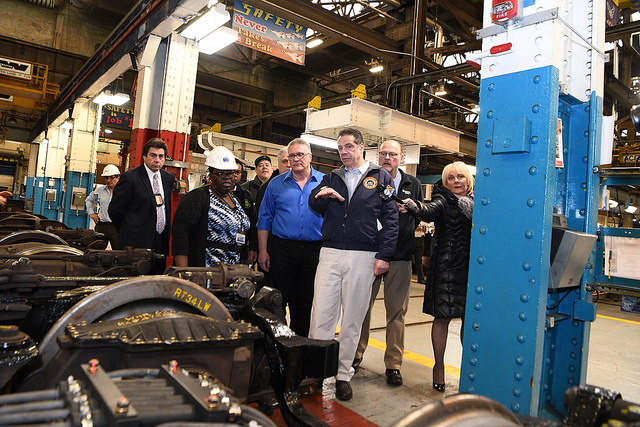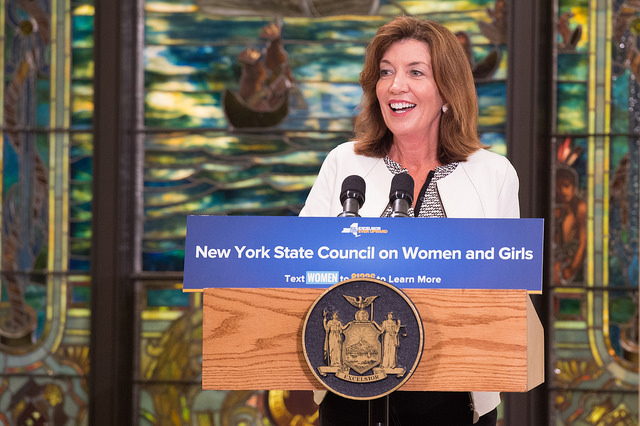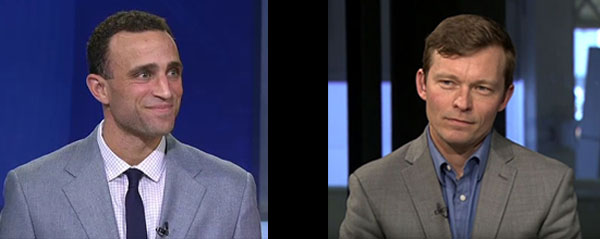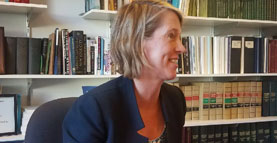Cuomo Faces Another Decision on MTA Funding ‘Lockbox’

Gov. Cuomo at an MTA-related event (photo: Don Pollard/Governor's Office)
A bill to create a “transit lockbox” passed both houses of the state Legislature at the end of the session last month, setting up a showdown between the Legislature and Governor Andrew Cuomo, who has presided over hundreds of millions of dollars in diverted MTA funds and has been hesitant to lose flexibility to use money allocated to MTA operations and improvements for other purposes, such as debt service. Cuomo vetoed an identical bill in 2013.
The legislation would fully prohibit the executive branch from diverting any funds dedicated to public transit, whether operational or capital. If any funds were to be diverted with approval of the Legislature, such as through the budget process or other legislative means, the governor’s administration would be required to provide a full accounting of the diversion to the Legislature, such as its impact on fares, capital needs, or maintenance.
Cuomo, who has taken heat for numerous “transit raids” throughout his tenure, vetoed a lockbox bill five years ago, but faces new pressure amid an ongoing crisis in the New York City subway system, which has seen deteriorated service and reliability and is in need of major repairs and upgrades. The bill passed both the Republican-led state Senate and Democrat-controlled Assembly without any dissenting votes. Its sponsors are counting on that increased pressure forcing Cuomo’s hand.
“Money meant for transit should be spent on transit. And if it doesn’t get spent on transit, then transit users deserve to know exactly why their money is being diverted and how it will impact their fares and their quality of service,” said Assemblymember Jeffrey Dinowitz, a Bronx Democrat and the Assembly’s main sponsor of the bill, in an emailed statement to Gotham Gazette.
In the Senate, the main sponsor was Senator Marty Golden, a Brooklyn Republican. In a statement about passage of the bill, Golden referred to the diversions as “shortsighted measures,” and said that the bill “ensures that we have the funding needed to bring the MTA transportation system up to speed.”
Estimates for the total dollar amount of diverted funds during Cuomo’s tenure reach the hundreds of millions. Mayor Bill de Blasio frequently accuses the governor of having raided the MTA’s budget of $456 million. The mayor’s office elaborated in July of last year, noting $391.5 million in diversions from the operating budget to the state’s general fund, and $65 million in “reduction[s] in state reimbursements to the MTA in 2017.”
During this year’s state budget negotiations, de Blasio repeatedly argued that the $456 million should be returned to the MTA by the state in order to cover the half of the $836 million emergency Subway Action Plan that Cuomo and his appointed MTA board chair, Joe Lhota, were asking the mayor to allocate in city funds. Cuomo refused, and, working with the Legislature, forced the city to pay using a state budget mechanism. With little recourse left, the city acquiesced, apparently content with the plan’s lockbox provisions. Three years ago, the city pledged $2.5 billion in city funds to seal a hole in the MTA’s five-year Capital Plan, in exchange for a promise from the state not to divert the funds. The state also promised additional funding, more than $8 billion, to that plan, which runs through 2019, though, as usual, the MTA has not drawn down very much of the allocated capital plan money as of yet.
The governor disputes the mayor’s numbers on diverted funds, and has noted in the past that the state contributes more to the MTA than the city, which is true but for the fact that much of the state money originates with city taxpayers and commuters. The MTA has countered the mayor’s allegations by noting that “diversion” is a misnomer, given that substantial portions of the moved funds go toward paying down the MTA’s debt, rather than being used to fund completely unrelated projects. The MTA has said that $235 million of the $456 million diversion went toward debt service, with another $169 million diverted to “direct capital aid,” $30 million for operating aid, and $22 million saved.
In Fiscal Year 2018, the MTA’s debt service payments reached $2.5 billion, a total of 16 percent of the Authority’s total operating budget. Ten years ago, in Fiscal Year 2008, the MTA’s debt service payments totaled $997 million. Increased debt service has coincided with growing debt, which has reached $38 billion this year; with the most recent capital plan boost in 2017, the debt is expected to reach $43 billion by 2024.
The “lockbox” is seen as a transparency and accountability measure, and the governor has in the past made his contempt for reporting on the diversions apparent. The governor vetoed the 2013 bill because of its lack of any “emergency” diversion powers, according to his veto statement, but critics charged that requirement of a “diversion impact statement” whenever money was to be diverted from the MTA played a part in his decision. An earlier bill that passed both houses and was signed by the governor in 2011 had been stripped of that requirement and added a provision allowing the governor to divert funds in “emergencies,” which was removed in the 2013 bill.
In his 2013 veto statement, the governor said that the bill would “repudiate” the 2011 compromise, despite his insistence that he had “never declared a fiscal emergency and directed such transfers.” In the end, he called the bill “unnecessary.”
The veto was harshly criticized by both transit advocates and good government groups alike. In Cuomo’s next executive budget, he proposed that $40 million be diverted from the MTA operating budget to finance debt service; the end result was $30 million to service debt. The governor wields enormous power in the state budget process.
This year’s bill again requires that any diversion of funds be accompanied by a diversion impact statement. The governor would have to publicly account for the full dollar amount of a diversion, which funds (operational, capital, or otherwise) will be depleted, the total amount of diverted funds over the preceding five years, and a “detailed estimate of the impact of diversion from dedicated mass transit funds will have on the level of public transportation system service, maintenance, security, and the current capital program.”
In fact, the new bill is identical to the old bill that Cuomo vetoed five years ago. But MTA-related pressure on Cuomo this time is greater than last time, with the governor earning low marks in polls for his handling of the MTA during his tenure and election year critics, including his opponents from the left and the right, making MTA management a key campaign issue.
Advocates want to see the bill signed, among other actions they are pushing Cuomo and state lawmakers to take to drastically improve the transit system. “With NYCT President Andy Byford's Fast Forward plan to modernize the subway on the table, Governor Cuomo and the state legislature must raise the billions of dollars that will be required to make the plan a reality and spend them as intended,” said John Raskin, executive director of Riders Alliance, in a press release upon the bill’s passage.
Dinowitz concurred, noting that the urgency of the measure has been amplified by the subway crisis being acute in a manner not seen five years ago.
“Service quality on our subways and buses has deteriorated, especially in recent years,” Dinowitz told Gotham Gazette in an emailed statement. “As we look at the significant price tag of the MTA’s Fast Forward plan as well as transit needs in the rest of New York State, we must ensure that our public transportation systems actually receive the funding that they are allocated.”
The subway’s demise, and what to do about it, has become a major issue in this year’s gubernatorial election. Cuomo has said he supports the long-term plan put forth by Byford, a relatively recent MTA hire brought in to save the subways and improve bus service, but the governor has said how to pay for it is still the big question. The Daily News reported in May that the subway overhaul plan drawn up by Byford would cost $37 billion over ten years.
Cuomo has promised to continue to push for a congestion pricing plan during the next session in Albany. The second-term Democrat must first be reelected this fall. Cynthia Nixon, his challenger in the Democratic primary, has also backed Byford’s plan, and says she would pay for it through congestion pricing, a new millionaires tax, and a carbon tax. Along with congestion pricing, Cuomo has indicated he will expect New York City to kick in more for the MTA -- a new five-year MTA capital plan will soon be negotiated. Cuomo has not expressed support for a carbon tax or an added millionaires tax, Mayor de Blasio’s favored potential funding stream.
The governor’s office did not give any indication of support or opposition to the lockbox bill when asked by Gotham Gazette. “This appears to be one of 557 bills that passed both houses in the last few weeks of session and will be reviewed by Counsel’s office,” said Cuomo spokesperson Tyrone Stevens.
***
by Ben Brachfeld, Gotham Gazette
@GothamGazette
EMILY’s List Backs Hochul for Reelection as Lieutenant Governor

Lt. Gov. Kathy Hochul (photo: Governor's Office)
One of the country’s most powerful political organizations, EMILY’s List, has endorsed Kathy Hochul for reelection as lieutenant governor of New York.
Hochul, a Democrat seeking a second term in the statewide position, is facing a primary challenge from New York City Council Member Jumaane Williams, with the vote just over two months away, on September 13.
EMILY’s List is a national organization founded in 1985 to “elect pro-choice Democratic women to office” that helps recruit, train, and support female candidates across the country. It is a powerhouse fundraising entity and claims over five million members. The group -- an acronym for Early Money Is Like Yeast, signifying the importance of early fundraising to the growth of electoral campaigns -- calls itself “the nation’s largest resource for women in politics” and boasts that it has “helped elect 116 women to the House, 23 to the Senate, 12 governors, and over 800 to state and local office.” It is a list that already includes Hochul, who became Governor Andrew Cuomo’s running mate in 2014 as he sought a second term and after his first-term lieutenant governor, Robert Duffy, declined to seek reelection.
“Lieutenant Governor Kathy Hochul has been a progressive champion New York families can count on,” said Stephanie Schriock, president of EMILY’s List, in a statement. “Kathy helped lead the way in New York’s fight for a desperately needed minimum wage increase and one of the most generous paid family leave policies in the country. Lieutenant Governor Hochul has tirelessly defended access to affordable health care, supported LGBTQ rights, and criticized Republican efforts to pass massive tax breaks for the wealthiest few. EMILY’s List is proud to endorse Lieutenant Governor Kathy Hochul’s campaign for re-election.”
Hochul speaks proudly of her history fighting for women’s reproductive freedoms and for LGBTQ rights, and highlights her work leading economic development projects for the Cuomo administration.
The challenge from Williams -- a Brooklyn representative who has the backing of several activist groups that make up The Working Families Party, as well as a handful of his City Council colleagues, among other individuals and groups -- is formidable. While Hochul has the advantages of incumbency and her ties to Cuomo and the larger Democratic establishment, help from EMILY’s List with fundraising, volunteers, and voter turnout could be pivotal. The group says it has raised over $500 million since its inception, including over $90 million during the 2016 election cycle, when it backed Hillary Clinton for president, among many other candidates.
Williams has repeatedly faced questions about his stance on abortion, which has evolved in recent years. He has said in the past that he held personal views in opposition to abortion but never acted in his official capacity to challenge reproductive rights. More recently, he has given full-throated support to a woman’s right to choose and made efforts to assuage concerns that he is against reproductive choice.
Hochul and her supporters have already repeatedly made reference to Williams’ views on women’s reproductive rights as well as his similarly evolved stance on marriage equality for LGBTQ people. Those lines of attack are likely to intensify as the campaign season heats up, especially if the two candidates engage in debates.
For his part, Williams has criticized Hochul for being unequivocally supportive of Cuomo (which she has said is her job as lieutenant governor), for being too centrist overall, and for her past opposition to driver’s licenses for undocumented immigrants (Hochul has expressed regret about how she handled the issue as Erie County Clerk a decade ago).
Hochul told Gotham Gazette that she has tried to understand why Williams and Cynthia Nixon, who is trying to unseat Cuomo in the Democratic primary, are mounting their campaigns, but that, ultimately, she believes the intraparty battles only advantage Republicans, in part by fracturing Democrats but also by forcing the diversion of resources from flipping Republican-held seats in the House of Representatives and New York State Senate, both bodies currently led by the GOP.
The EMILY’s List endorsement of Hochul comes as the group is working to help flip the House this November, among other races at various levels of government it is hoping to support women in winning. In New York, for example, EMILY’s List is behind Liuba Grechen Shirley, who is seeking to unseat Republican Representative Peter King of Long Island. The organization has also significantly expanded its state and local efforts, Schriock recently explained to CNBC, saying that Republican-controlled state legislatures are “devastating women and families.” Other EMILY’s List endorsements in New York races could come ahead of important general election votes for New York House and State Senate seats.
“Our vision is a government that reflects the people it serves, and decision makers who genuinely and enthusiastically fight for greater opportunity and better lives for the Americans they represent,” the EMILY’s List website explains of the organization’s mission. “We will work for larger leadership roles for pro-choice Democratic women in our legislative bodies and executive seats so that our families can benefit from the open-minded, productive contributions that women have consistently made in office.”
EMILY’s List has entered somewhat new territory this year given the exponential groundswell of women interested in running for office and those who have made the leap, in many cases with support from EMILY’s List, which can come in forms that don’t include a formal endorsement. The organization has faced several difficult choices about where and when to get involved in Democratic primaries with two or more women running, and in some cases where female candidates are taking on establishment-backed male candidates (as The New York Times recently explored). The organization is closely aligned with the Democratic establishment and is careful in assessing viability of campaigns.
It almost never endorses primary challengers to sitting Democrats, making it unlikely to back Nixon in her quest to unseat Cuomo. EMILY’s List has supported another Cuomo opponent, Stephanie Miner, in her past, successful effort to get reelected as mayor of Syracuse. Miner is attempting to make the general election ballot for governor on a newly-created independent line. On the other hand, there is a wide open Democratic primary for Attorney General of New York that includes three women: New York City Public Advocate, the state party’s designee and a former endorsee of EMILY’s List, as well as Fordham Law professor Zephyr Teachout, and former Cuomo and Clinton aide Leecia Eve. Representative Sean Patrick Maloney is also running.
If Hochul is successful in defeating Williams in the primary, she will join a ticket with the Democratic nominee for governor to face the joint tickets of other parties on the ballot.
***
by Ben Max, Gotham Gazette
@tweetBenMax @GothamGazette
Max & Murphy Podcast: Attorney General Candidate Zephyr Teachout

Ben Max, left, of Gotham Gazette, and Jarrett Murphy, right, of City Limits
July 9, 2018 - Max & Murphy Podcast: Attorney General Candidate Zephyr Teachout

Zephyr Teachout is pursuing the Democratic nomination for Attorney General of the State of New York, part of a somewhat crowded group of candidates that also includes New York City Public Advocate Letitia James; Representative Sean Patrick Maloney; and Leecia Eve, a Verizon executive who is a former Hillary Clinton and Andrew Cuomo aide.
Teachout joined the podcast to discuss her vision for becoming the next Attorney General, highlighting the importance of fighting what she calls the law-breaking of President Donald Trump, his businesses and his presidential administration. Teachout also discussed fighting corruption in state government, and how the Attorney General must both work closely with and be an "independent voice" from the gubernatorial administration, no matter who the governor may be (Teachout ran a primary against Gov. Cuomo in 2014 and was campaign treasurer for Cynthia Nixon in this year's election until Eric Schneiderman's abrupt resignation created this year's AG electoral scramble). Teachout expressed concerns about Cuomo's concentrated power and the facts of the federal corruption cases occurring this year and involving top former aides to Cuomo, and much more.
Listen to the full conversation and let us know what you think -- we're on Twitter @TweetBenMax and @JarrettMurphy, and guest @ZephyrTeachout. You can listen to the episode through the embedded audio below or download the episode wherever you get your podcasts.
***
by Ben Max, Gotham Gazette
@tweetBenMax @GothamGazette




